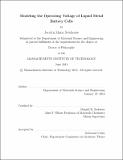Modeling the operating voltage of liquid metal battery cells
Author(s)
Newhouse, Jocelyn Marie
DownloadFull printable version (6.939Mb)
Other Contributors
Massachusetts Institute of Technology. Department of Materials Science and Engineering.
Advisor
Donald R. Sadoway.
Terms of use
Metadata
Show full item recordAbstract
A one-dimensional, integrative model of the voltage during liquid metal battery operation has been developed to enhance the understanding of performance at the cell level. Two liquid metal batteries were studied: Mg-Sb for initial development of the model and Li-Bi for demonstration of generality. The baseline of the model is the thermodynamic potential, which is the maximum potential upon discharge. Emf measurements were used to confirm the literature values for Mg-Sb liquid alloys and calibrate a two-phase Mg-Sb reference electrode. The charge transfer kinetics at the alloying electrode were studied using the galvanostatic pulse method and a novel working electrode design. The contribution of the charge transfer reaction to the cell operation was found to be negligible for both the Mg-Sb and Li-Bi electrodes (less than 5 mV). Mass transport in the positive electrode was examined and found to depend significantly on the concentration dependence of the interdiffusivity and the volume change with alloying. The interdiffusivities for both Mg-Sb and Li-Bi were measured. A semi-analytical expression was proposed and agreed with the numerical solution determined using the finite difference method. Mass transport in the electrolyte was modeled using a boundary layer diffusion approximation. For the IR drop, the solution resistance was assumed to be constant. The predicted operating voltage for both the Mg-Sb and Li-Bi was consistent with experimental data.
Description
Thesis: Ph. D., Massachusetts Institute of Technology, Department of Materials Science and Engineering, 2014. This electronic version was submitted by the student author. The certified thesis is available in the Institute Archives and Special Collections. Cataloged from student-submitted PDF version of thesis. Includes bibliographical references (pages 179-188).
Date issued
2014Department
Massachusetts Institute of Technology. Department of Materials Science and EngineeringPublisher
Massachusetts Institute of Technology
Keywords
Materials Science and Engineering.